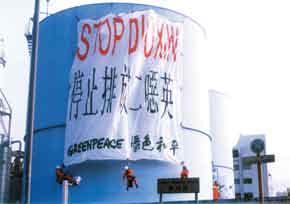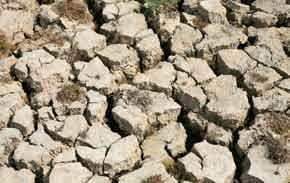
11 minute read
Water and Sewage Treatment
Located inland on a dry plateau in China’s northeast region, Beijing is a city that struggles with severe water shortages. Beijing’s water availability per capita is just 1/32 of the international average level. 118 In 2007, Beijing’s annual water consumption reached 3.4 billion m 3 . 119
The Olympic Games will greatly increase the city’s demand for water. An increase of 4.7 million m 3 in domestic water use is expected during the Games. 120 According to Nanfeng Chuang Magazine, over 300 million m 3 of water from four major water reservoirs in Hebei — the Huangbizhuang reservoir and the Gangnan reservoir in Shijiazhuang municipality and the Wangkuai reservoir and the Xidayang reservoir in Baoding municipality — will be set aside and diverted to Beijing to change the water in its artificial lakes and rivers in order for the city to have clear lakes during the Games.
Beijing’s water comes from two major reservoirs — the Miyun Reservoir and Huairou Reservoir, which are both situated to the northeast of the city. The Miyun Reservoir provides Beijing with most of its drinking water, and the Huairou Reservoir provides water for agriculture.
The Beijing Water Authority was established in 2004 to manage water quality and capacity. The Beijing Environmental Protection Bureau is charged with protecting and managing water sources. Working together, the two agencies are responsible for guaranteeing water sources, quality, and supply for the city. 121
According to a Beijing Daily Report,
Beijing will benefit from some 480 million m 3 of recycled water in 2007, about 14% of total water consumed in Beijing that year, and the quantity is expected to increase to 600 million m 3 in 2008 through citywide initiatives. 122
Beijing has instituted major water projects to divert water from neighboring provinces in order to feed Beijing’s increasing water demand. A water redirection project will take water from Hebei Province via a 225 km canal to move over 300 million m 3 of water to Beijing. This project was scheduled for completion in April 2008. 123 Greenpeace was unable to confirm the completion of this project.
A number of new Olympic venues and refurbished venues such as the National Stadium (Bird’s Nest), the Olympic Green, and the Olympic Forest Park include water saving design including rainwater collection, water efficiency, water re-use and water recycling features to reduce water demand during and after the Games.
In Beijing, the Games have provided an opportunity to develop the city’s sewage treatment structures. According to official sources, by May 2007, nine out of 14 planned sewage treatment plants have been built and the five remaining ones are under construction. 124
Beijing Commitments
1. Beijing’s drinking water will meet WHO standards. 125
2. The drinking water source areas will be continuously protected. 126
118. China Daily. “Project to increase Beijing’s water supply.” Updated: 2004-08-19 http://www.chinadaily.com.cn/english/doc/2004-08/19/content_366665.htm 119. Beijing Water Authority. 2007 Beijing water projects summary. http://www.bjwater.gov.cn/tabid/134/InfoID/13694/frtid/133/Default.aspx. 120. China’s Environment in 2006: Changes and Struggles. “How should Beijing cope with water shortage when hosting the 2008 Olympic Games.” Social Science Academy
Press, 2006. 121. UNEP, “Beijing 2008 Olympic Games: An Environmental Review,” p.117. 122. BOCOG Media Center. “Beijing Benefits from Recycled Water.” http://en.beijing2008.cn/58/89/article214028958.shtml. 123. People’s Daily. “South-North Water Diversion emergency water diversion channel has been completed.” http://env.people.com.cn/GB/7107878.html (in Chinese). 124. BOCOG, “Beijing improves water quality.” http://en.beijing2008.cn/57/06/article214070657.shtml (in Chinese) 125. BOBICO, “4 Environmental Protection and Meteorology” p.57. 126. BOBICO, “4 Environmental Protection and Meteorology” p.57.
3. Guanting Reservoir’s water quality will be gradually cleaned and restored to drinking water quality. A water diversion project to reduce leakage and to increase channel water rate, strengthen surface water and ground water integration will be completed. 127
4. Water-saving facilities and non-flush toilets will
be used, and rainwater collection and reuse systems will be installed in competition venues and the Olympic Village. 128
5. The daily capacity for sewage treatment for the city of Beijing was 1.08 million tonnes as at 1999 and will rise to 2.8 million tonnes in 2008, which equals 90% of the sewage generated at the time of the Games. The reuse rate of treated water for Beijing will reach 50% by 2008. 129
Greenpeace Guidelines
Guideline 18 - Use sustainably managed water management techniques, practices and products to avoid the exploitation of new water sources. Water conservation, selection of native plants and recycling options should be used whenever possible. Guideline 19 - Restore natural water cycles in the development area, minimize run-off and stormwater by establishing systems that retain, re-use and recycle water on-site.
Selected Achievements
Olympic site
BOCOG has made a number of significant
achievements related to water saving and sewage treatment to allow treated water to be used at the Olympic site. These achievements include:
According to official statistics, 15 projects including
the National Stadium (Bird’s Nest), Olympic Green, and Wukesong Baseball Field have incorporated rainwater collection systems, capable of making use of about one million tonnes of rainwater. 130
Olympic Forest Park:
The Park contains an advanced enclosed water circulation system. Official figures say that about 1.34 million
m 3 , or about 95% of rainwater inside the park can be reused for irrigation. 131 This system will also support an ecological wetland area designed for educational purposes. During drought periods, reused water will come from the Qinghe Wastewater Treatment Plant.
Sewage and human waste derived from visitors are treated using advanced composting and source separation methods that allow the waste to return to the park as fertilizer. All park toilets will make use of these advanced technology.
Olympic Forest Park
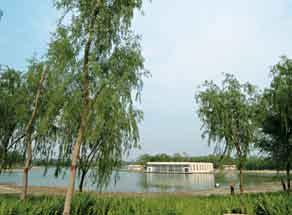
Olympic Green:
According to official sources, the Olympic Green has
a systematic and comprehensive rain gathering water reuse technology that has a collection coverage area of 97 hectares. The water reuse rate at the Olympic Green has reached 80%. Each year this system replenishes about 320 000 m 3 of ground water, which also adds about 90 000 m 3 to the water system. The reused water can provide up to 50 000 m 3 of water for irrigation of the grounds. 132 All wastewater from the Olympic Green – will be recycled at Qinghe and Beixiaohe Wastewater Treatment Plants. The treated water will be used for landscape irrigation and toilets in the Olympic Green.
Bird’s Nest:
China’s first rainwater recycling system has been installed in the stadium. The system use underground collecting facilities that can process up to 100 tonnes of rainwater per hour, 80 tonnes of which can be re-used for landscaping, fire-fighting and stadium cleaning. 133
127. Beijing’s Green Olympics Action Plan, http://www.beijing2008.cn/bocog/environment/guidelines/n214067229.shtml (in Chinese) 128. BOBICO, “4 Environmental Protection and Meteorology” p.57. 129. BOBICO, “4 Environmental Protection and Meteorology” p.57. 130. “The 14th session of the capital city planning exhibition on building design” Catalogue. p.5. Organized by the Beijing Municipal Planning Commission and the Beijing “2008” Project Construction Headquarters Office. 131. Beijing Evening news. “Following natural design. Introduction to the Olympic Forest Park.” http://2008.sohu.com/20080626/n257762151.shtml 132. “The 14th session of the capital city planning exhibition on building design” Catalogue. p.94. Organized by the Beijing Municipal Planning Commission and the Beijing “2008” Project Construction Headquarters Office. 133. 7th World Conference on Sport and the Environment brochure” p.29. 27
Water treatment system at Olympic Venues:
The sewage and wastewater reuse systems at the Olympic site use various treatment methods for water processing such as the Fixed Activated Sludge Treatment (FAST) wastewater system 134 which uses cultivated microorganisms to digest the wastewater to transform it into a clear, odorless and high-quality effluent. FAST
has obtained certification from the Canadian
Great Lakes water quality standard (the most stringent marine standard in the world). 135 Another technology that is used for wastewater treatment is the Membrane Biological Reactor (MBR). 136 These technologies have allowed some venues to achieve “zero-waste.”
Each of the five venues including the National Aquatics Center (Water Cube), the Shunyi Water Park, the Olympic Tennis Center, the Olympic Forest Park, and the Olympic Center all have wastewater treatment systems, with a treatment capacity of one million tonnes in total.
Qinghe Wastewater Treatment Plant
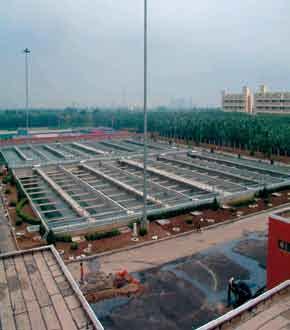
Beijing
Beijing plans to build 14 Wastewater Treatment Plants from 2001-2006. In 2006, the newly constructed sewage disposal plants’ daily disposal capacity reached 2.9 million tonnes. 137
According to the UNEP’s Environmental Review, the central government has also closed down heavily polluting enterprises in the catchment area close to the reservoir to guarantee the quality of water supply to the city. 138 Official sources report that in order to ensure that the quality of water from Miyun and Huairou Reservoirs will continue to meet portable water standards, relevant government authorities have banned illegal construction and fish farming, closed down small mines on the upper stream, as well as developed rural sanitation facilities in the protection zones for ground water resources. 139
Missed Opportunities and Mixed Results
Water efficiency is the most effective way to reduce
water demand. Upgrading outdated water infrastructure is vital to ensuring efficiency. The Olympics offered Beijing a great opportunity to improve the efficiency of its water infrastructure to meet increased demand from the Games. While innovative water reuse technologies were installed in Olympic venues, more could have been done to incorporate these technologies in infrastructures more broadly across the city. Such initiatives would reduce water demand and improve water efficiency.
In many cases, although water reuse technologies were introduced into venues, they did not go far enough to ensure that the Games had a minimal impact on the city’s precious water supply. The Shunyi Olympic Rowing and Canoeing Park, the third largest venue in the Games, is one such example. This venue is designed with water saving features: it combines rowing and canoeing venues into one facility — a first for any Olympic Games, in an attempt to minimizes Olympic water demands. There will also be a 72 000 m 3 / day water treatment plant in the facilities for water re-use. However, this venue still draws a vast amount of water from the Miyun water reservoir. 140 This large, water-demanding venue should have gone further to eliminate its reliance on precious water sources.
Water conservation and reuse is particularly important for Beijing due to the city’s large dependency on water diversion and groundwater to meet the city’s demand, thereby creating water shortage problems for other regions.
Furthermore, according to official statements, the
Beijing Municipal Water Authority announced in 2007 that water in the capital had passed all 106 tests for contaminants as
134. For more information on the FAST wastewater treatment technology please see U.S. Environmental Protection Agency. http://www.epa.gov/NE/assistance/ceitts/ wastewater/techs/fast.html 135. U.S. Environmental Protection Agency. http://www.epa.gov/NE/assistance/ceitts/wastewater/techs/fast.html 136. For more information on one system of water treatment technology please see http://www.chinawater.net/chinaWaterToday/viewpaper.asp?id=5884 137. BOCOG, “Beijing 2008: Environmental Protection, Innovation and Improvement: 2001-2006 Update,” p.42. 138. UNEP, “Beijing 2008 Olympic Games: An Environmental Review,” p.120. 139. BOCOG, “Beijing 2008: Environmental Protection, Innovation and Improvement: 2001-2006 Update,” p.39. 140. UNEP, “Beijing 2008 Olympic Games: An Environmental Review,” p.68.
required by new national standards. Fan Kangping, director of the Water Quality Center of Beijing Waterworks Group, said the city’s water had been potable since 2003. 141 However, due to secondary pollution caused by the estimated 7 000 km of underground pipes, authorities acknowledge that when water reaches residents, it often has a metallic taste. The Beijing municipal government should upgrade major water pipes in the city as well as pass strong legislation requiring private buildings to upgrade their piping systems to ensure water quality at the reservoir is of similar quality when it reaches individual homes.
Greenpeace Recommendations – Beijing Games and Beyond
Beijing Beyond 2008
To ensure water supply for Games venues is a huge burden for any city, perhaps even more so for a city affected by persistent water shortage such as Beijing. After the Games, Beijing should increase efforts to maximize water efficiency, water recapture, treatment and reuse as well as improve existing infrastructure to ensure a secure future for water supply to support a growing city. Beijing should also continue to protect its water source as well as pass relevant policies for industry to push them towards clean production and to regulate agro-chemicals to ensure water source quality.
The preparation process for the Games have also highlighted water resource problems in the region. Water scarcity is a growing global concern. At this year’s World Economic Forum in Davos, Switzerland, UN secretary Ban Ki-moon warned that water stress poses a risk to economic growth, human rights, health, safety and national security. Both international and domestic media such as Nanfeng Chuang and the Associated Press 142 have reported on the impact of longdistance water diversion projects on Beijing’s neighboring regions. Greenpeace urges Beijing to radically re-think the city’s long-term water consumption and conservation policy to avoid negatively impacting other regions.
China Beyond 2008
Successful water treatment, re-use and rain collection technologies used at the Games should be applied widely to other Chinese cities as much as possible, especially in areas that have struggled with severe drought in the past. Furthermore, China’s northeast region should take a critical look at its water projects to ensure that attempts to supply China’s urban centers will not affect access to water for rural areas, agricultural water, water safety and security for future generations.
Future Olympic Games - Recommendations
to the IOC
The IOC should strongly promote a wide application of state-ofthe-art technologies to minimize demand on water resources in all future Games venues. Sustainable water management techniques should also be applied to new infrastructure and buildings in and around host cities. Future Olympic host cities should be strongly discouraged from bringing water in from distant regions to meet increased water demands due to the environmental and economic burdens on other areas.
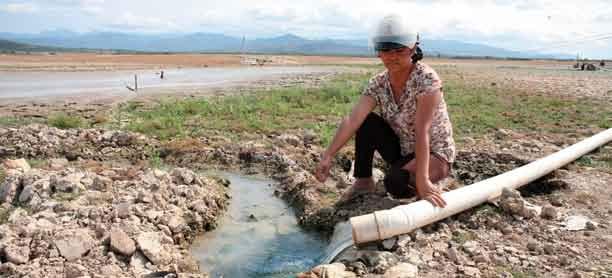
141. China Daily. “Beijing tap water now safe to drink.” July 4th, 2007. http://en.beijing2008.cn/news/olympiccities/beijing/n214105640.shtml 142. Associated Press. “Group critizes Beijing water diversion plans.” http://news.findlaw.com/ap/i/1104/06-26-2008/20080626083503_059.html









